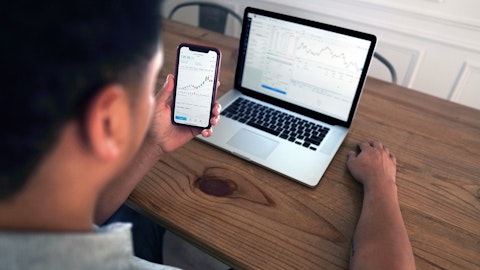Christ Snyder: So back on the conference call in November, the Company talked about book-to-bills approaching a more normalized 1.0x. The quarter came in a bit below that at 0.94. So, were orders in the quarter softer than you would have expected back in November? Or for book-to-bills to improve as the year goes on and kind of reach that more normalized average of 1.0x for the full year?
Neil Dougherty: Yes. I mean, if you go back to the November quarter, we talked about 8 points of specific headwinds that we were facing from currency and from China, Russia, those things, and that we expected that we were also recognizing macro on — softness on top of that or anticipating macro softness on top of that. So, by and large, I’d say the quarter came in largely in line with our expectations. It’s obviously hard to put a quantification on macro. I mean, looking forward, as Satish has said, it’s very difficult to call at this point. We’ve attempted to give you some parameters with which to think about the business. Mark has commented that in our funnel, which looks out over the next couple of quarters would indicate demand that’s more or less in line with what we just saw in the first quarter.
And then, I did state in my prepared comments that if that kind of order trend remain in place for our entire remainder of our fiscal year, we’d expect to still be able to deliver a low single-digit revenue and EPS growth. So, we’re taking it one quarter at a time, but that should hopefully give you some guardrails with which to think about the business.
Christ Snyder: Thank you. I appreciate that. And then just kind of staying on orders for fiscal Q1, is there anything or color you could provide around how orders in China did during the quarter, given a lot of the disruption over there? And also government and defense business orders, just given some of the budgeting resolution processes going on? Thank you.
Mark Wallace: Sure. This is Mark. I’ll comment on both of those. So we faced, as everyone did, the unanticipated breakout from COVID, and there were some incremental trade restrictions that happened in the month of December. We did see orders decline in China. They actually increased sequentially. So, that kind of indicates the unusual seasonality that we faced. But it was — relative to what we were expecting to face with some of the declines, I was pleased with our response. And it really continues to be in line with what we’ve talked about in the past, which is our ability to pivot to new opportunities and the breadth of our customer base in China, which continues to be an area of strength for us. And that includes automotive, where the business was up.
Some of the private networks, which is a new use case for 5G from an industrial standpoint, continue to show signs of growth for us. Mature process technologies for semiconductor. So, as we go forward and the economy begins to normalize there and maybe reopen into the second half, we’ll keep a close eye on that as well. Aerospace defense, as Satish noted in his opening comments and otherwise, we saw a strong growth — order growth, in the U.S. That’s a direct byproduct of the budget being approved much earlier this year than last year. And what we see happen in Q1 was not new program starts, but rather multiyear programs that were stalled because of continuing resolution turn back on and some of that spend continue to flow. So, as we get through the next several months and quarters, and the record high RDT&E budget flows through the process, we hope to see some additional tailwinds there.
Outside the U.S., with the geopolitical situation, we expect to see continued long-term demand for defense modernization. So, we’re positioned well to capture that as well.
Satish Dhanasekaran: Yes. Just maybe to add a comment to Mark, the space and satellite also continues to inflect for us in the aerospace defense business, and is showing some momentum there with customers, too.
Operator: Our next question comes from Aaron Rakers with Wells Fargo.
Aaron Rakers: I’m going to go back to kind of the order and backlog dynamics. Neil, I think last quarter, you had mentioned that you were maybe about four or five weeks of kind of inflated or elevated backlog relative to normal. I’m curious where that stands right now? And does your low single-digit assumption assume — growth-wise assume kind of back to normalized backlog levels through the course of the year?
Neil Dougherty: Yes. It’s a great question. So obviously, revenue outpaced orders by about $80 million within the quarter. You can do the math on it. But if we see a similar environment persist for the remainder of the year, which is, again, in line with the guardrails what I put out there, we’d burn $300 million plus of that kind of abnormal backlog. So, it may not get us all the way home, but it would get us a significant chunk of the way towards normalization of the backlog over a multi-quarter period. We always knew it would take multiple quarters to normalize the backlog. And while this is just one scenario, I think it’s not out of line with our expectations.
Aaron Rakers: Okay. And that’s helpful. And then, a quick follow-up. Just on the semiconductor business, you continue to perform well. And I don’t know the answer to this question, but I’ll just put it out there, is that — is there any kind of disruptions? I think there’s been a supplier in the semiconductor supply chain that had seen, I think, some cyber attack issues. Is that at all impactful to your business or not?
Satish Dhanasekaran: No, not at all. For us, we serve the wafer stage, which is on the front end. It takes a longer lead time from our fabs to put capacity. And we see customers sticking with their plans for 5-nanometer and below. And equally, we’re also quite pleased with the progression we’re making to further add more applications into our solution stat, whether it is high-power applications for certain chips or silicon photonics or millimeter wave. So we continue to build that portfolio out.
Operator: Our next question comes from Jim Suva with Citigroup.
Jim Suva: The first part of my question is, Neil, you made the question that are the statement as the year plays out, if it does according to plan, you’re looking at kind of sales growth. I think I heard you say low mid-single digits, and then you said — and EPS growth. Did you mean the EPS growth to be positive or like in that same range of sales growth? Because typically, earnings per share grows at a bigger or a magnitude about sales growth. Then I’ll have a follow-up. Thank you.
Neil Dougherty: Yes. So what I said, first of all, we weren’t guiding the year. What we said is, it’s a highly uncertain environment, it’s difficult to know. But if the demand stays consistent with where — what we saw in Q1 through the remainder of our year, we would expect to deliver in that scenario low single-digit revenue and low single-digit EPS growth. Obviously, our model calls for higher revenue growth than that with 40% operating leverage, which enables us to get to double-digit EPS growth. So, in a scenario where revenues are growing at a lower level, coupled with this inflationary environment, which is a bit abnormal, we’d be looking at low singles for both revenue and EPS. Again, under that specific scenario where our orders remain more or less in line with what we saw in the first quarter.
Jim Suva: Great. And then my follow-up question is, I believe it was in the month of December that had the incremental trade restrictions against China. I think that’s right. And so when we think about your commentary for 2023, if things are consistent, how much of sales impact is that incremental restrictions? Is that what you’re referring to in your prepared commentary about the kind of 3 to 4 points — or 6 to 7 points of growth impact, or can you just help me flesh out the impact of the trade restrictions? Thank you.
Neil Dougherty: So, the new China trade restrictions that came about in December is an additional 1 to 2 points of headwind for us over the longer term. The comment about 6 to 7 was — on the call last quarter, I outlined what at the time we thought was going to be 8 points of headwind coming from China, Russia and FX. As we got to the end of the quarter, what we thought was going to be 8 was more like 6.5, so call it 6 to 7, and that’s largely because the dollar backed up a little bit. So, the FX impact was less than originally expected. The China impact was slightly less as well.
Operator: Our next question is from Matthew Niknam with Deutsche Bank.
Matthew Niknam: Maybe just a follow-up on that last one. On the Analyst Day, I’m just wondering any initial thoughts on what we could expect on March 7th in terms of just updates to longer-term targets? And then just on the M&A backdrop, I’m just wondering, what’s the latest you’re seeing in terms of opportunities and valuations. And I know in the past you’ve been focused on some smaller size software deals. I’m just wondering if that’s still the focus or maybe whether you’re open to larger deals, just considering the pullback in private market valuations. Thanks.
Satish Dhanasekaran: Yes. Thank you. I look forward to sharing the forward-looking view on the market fundamentally at the Investor Day. Across our end markets, we have — we see innovation accelerating. And I think we’ll lay out Keysight’s strategy to go into set those exciting long-term opportunities. So that’s number one. But I think with regard to M&A, clearly, if you look at how we’ve grown, we’ve been disciplined in actioning M&A of all sizes. You’ve seen us do Anite and Ixia, slightly larger scale and then a lot of technology tuck-ins, which have helped us complete the workflow and actually create greater value for customers and also expand our margins in the process. So from that perspective, we remain active in exploring new markets and targets as well.
But again, as I mentioned before, we have strong strategic and financial hurdles that we have to meet as gates before we go ahead and transact the business. On the valuation front, on the margin, we think the valuations are likely to come in as more of the market reality sets in with a number of the firms, so. And with the strong balance sheet and cash position, we remain active in exploring opportunities.
Operator: Our next question is from Adam Thalhimer with Thompson Davis.





